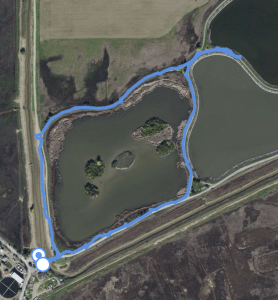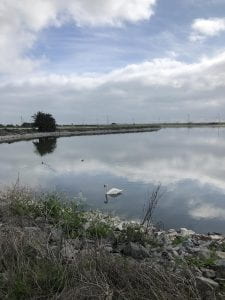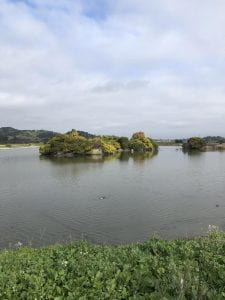https://ebird.org/checklist/S66415425
Month: March 2020
Field Lab Entry 6
Ebird List Link: https://ebird.org/checklist/S65463699
Date: 03/05/2020
Location: Las Gallinas Valley Sanitary District, Marin County, (38.027411, -122.515583) at an elevation of approximately -5 feet (-1.524 meters). Refer to the map below for where observations were recorded.
Site Description: The site would be classified as a valley, surrounded by mid to larger-sized mountains. Mount Diablo was located to the East, and Mount Tamalpais was located to the west. General topographical features of the site included a freshwater marsh, irrigated pastures, storage ponds, and a saltwater marsh. Most of our observations were done at the first and largest pond on the trail. This pond had three small islands with shoreline areas and areas of dense vegetation at their centers. The shores of the ponds were lined by a variety of grasses and rushes. The area overall had a very sparse amount of trees. The irrigated pastures located around the edge of the ponds provided a large open-aired environment. The most abundantly observed species were: Red-winged Blackbirds (300), Mallard Ducks (52), Tree Swallows (30), Cinnamon Teals (30), American Coots (19), Canadian Geese (18), Double-crested Cormorants (15), American Crows (12), Green-winged Teals (10), White-crowned Sparrows (10), Marsh Wrens (11), Snowy Egrets (9), Common Mergansers (7), Common Gallinules (7), Northern Harriers (6), Black-crowned Night-Herons (6), Northern Shovelers (6), Black Phoebes (5), and Short-billed Dowitchers (5). Other species observed were: Eurasian Collared-Doves (4), Wilson’s Snipes (4), American White Pelicans (4), European Starlings (4), Common House Finches (3), Gull species (3), Killdeers (3), Mute Swans (3), Blue-winged Teals (2), American Wigeons (2), Pied-billed Grebes (2), White-tailed Kites (2), Red-tailed Hawks (2), Golden-crowned Sparrows (2), Common Yellowthroats (2), a Song Sparrow (1), a Wrentit (1), a Common Raven (1), a Downy Woodpecker (1), a Turkey Vulture (1), a Great Egret (1), a Forster’s Tern (1), a Greater Yellowlegs (1), and a Bufflehead (1).
Species Account: A unique bird call was heard coming from inside the dense vegetation near the edge of one of the marsh areas. The call was very high pitched and was exhibited in bursts of threes. The call would best be described as a “wichety-wichety-wichety” noise. Based on its call, I assumed it would be some type of songbird. It took several minutes of waiting in silence before the bird moved to a higher-up area in the dense vegetation, making it more easily spottable. I thought that the bird was either really alert in our presence, or that remaining low in vegetation was a characteristic of its behavior (for example, when foraging). The first thing I noticed when locating the bird through my binoculars was the distinctive features of its plumage near the face. The throat of the bird was a brilliant bright yellow which highly contrasted with the black mask across its eyes. The bird was identified as a Common Yellowthroat. Common Yellowthroats (Geothlypis trichas) are of the order Passeriformes and family Parulidae. They are medium to small-size songbirds, more specifically warblers. To scale, their body size is slightly smaller than that of a Ruby-crowned Kinglet. Their body shape is round, with a rounded head and slightly rounded tail. Their beaks are small and pointed, which aids in insect foraging. The males have a bright yellow throat, black eye mask, and thin white line separating the upper part of the mask from the olive-brown color of the rest of the body. The females also have a yellow throat and olive-brown body color but lack the black eye mask. This type of bird inhabits open areas with thick, low vegetation. For example, the marsh in which we observed our Yellowthroat. As insect foragers, they spend a large amount of their time in the thick, low vegetation searching for food. Yellowthroats are short-distance migratory birds, moving to the southern United States for winter. During migratory periods, Yellowthroats may join other warblers in mixed flocks. The males are the ones that sing the “wichety-wichety-wichety” song we heard. However, both sexes make a “chuck” noise.


Sources:
- “Common Yellowthroat – EBird.” Ebird.Org, https://ebird.org/species/comyel/. Accessed 22 Mar. 2020.
- “Common Yellowthroat Overview, All About Birds, Cornell Lab of Ornithology.” Www.Allaboutbirds.Org, https://www.allaboutbirds.org/guide/Common_Yellowthroat/id. Accessed 22 Mar. 2020.
- “Common Yellowthroat – Audubon Guide to North American Birds.” Audobon.Org. https://www.audubon.org/field-guide/bird/common-yellowthroat. Accessed 22 Mar. 2020
Narrative: Observations occurred along a trail over 1.13 miles. The weather was cloudy with mild winds. The temperature was around 60 to 64 degrees Fahrenheit. Great diversity and abundance of species were observed across the area. Over the duration of the trip (207 minutes), forty-two species were observed. There were several behaviors I noted down for some of the species that I found interesting and potentially helpful for future identification. There were groups of different songbirds hiding in low vegetation near the edge of the water, they moved around very quickly and it was really difficult to identify them. However, I noticed that the Marsh Wrens all had their tails cocked upwards to the sky, which made distinguishing them from sparrows and other wrens easier. I also noticed that the Red-winged Blackbirds were gathered in large groups and were extremely vocal. Mixed in with the Red-winged Blackbirds were some European Starlings. I found it really interesting for two species to be mixing together and getting along. This contrasted with the interaction I observed between a Northern Harrier and American Crow. The Northern Harrier was flying in the open above an irrigated pasture, low to the ground and likely hunting. Swooping in from another direction, an American Crow mobbed the Northern Harrier. The crow appeared to annoy the Harrier enough that it flew away, leaving the area to the crow. It was really fascinating to me to be able to see two types of interactions between species in one environment, ranging from mutual acceptance of the presence of each other to purposely driving one another away.
Additional Photos or Media:
Field Lab Entry 5
Ebird List Link: https://ebird.org/checklist/S65448032
Date: 02/27/20
Location: Redwood Creek and Muir Beach, Marin County (37.8622617, -122.5747671) at an elevation of approximately 0 feet (0 meters). Refer to the map below for where observations were recorded.
Site Description: General topography of the site was relatively flat with medium-sized hills surrounding the area. Sightings were done along the Redwood Creek trail, starting inland and then looping out towards Muir Beach on the coast. The habitat would best be characterized as a riparian zone. The creek running through the area was lined by dense to moderately packed willow trees, as well as various varieties of grasses and brushes. Closer to the coast trees became sparser and brush became the dominant vegetation, creating a more open-aired environment. The most abundantly observed species were: American crows (15), Black Phoebes (6), Turkey Vultures (5), White-crowned Sparrows (5), Song Sparrows (5), Red-winged Blackbirds (5), Anna’s Hummingbirds (4), Pygmy Nuthatches (4), Fox Sparrows (3), and Lincoln’s Sparrows (3). Other species observed were: Wrentits (2), American Robins (2), Common Finches (2), a Great Blue Heron (1), a Northern Harrier (1), a Red-shouldered Hawk (1), a Red-tailed Hawk (1), a Downy Woodpecker (1), a Peregrin Falcon (1), a California Scrub-Jay (1), a Steller’s Jay (1), a Chestnut-backed Chickadee (1), a Ruby-crowned Kinglet (1), a Lesser Goldfinch (1), and a California Towhee (1).
Species Account: A bird was spotted soaring high in the open air above the hills near the coast. The most common birds that I have observed exhibiting this same type of soaring behavior are Red-tailed Hawks and Turkey Vultures. The bird was a great distance away, but close enough that I did not see a red tail, eliminating the possibility of it being a Red-tailed Hawk (assuming that it was an adult and had enough time to develop its red tail feathers). The bird soared with its wings in a “V” shape, which appears similar to the flight of the Turkey Vulture. However, the soaring bird did not have a red, featherless head and had distinctly lighter plumage than the Turkey Vulture would. I noticed that the bird would soar around in circles for a while and then plunge down, which led me to believe that this bird is predatory and was hunting for food. From the distance I was at, I did not hear the bird make any sort of call or noise. From the brief glimpses, I caught of the bird’s face it had almost owl-like facial features, which included bright eyes and a flatter, disc looking face. The bird was identified as a Northern Harrier. Northern Harriers (Circus hudsonius) are of the order Accipitriformes and family Accipitridae. They are medium-sized hawks with slender bodies, broad wings, and long, rounded tails. The plumage of males is grey and white, while females are brown. Their most distinctive feature is the white patch at the base of their tail. As adults, both sexes have bright yellow-colored eyes. Their disk-shaped faces and stiff facial feathers are similar to that of an owl, helping to direct sound when hunting for prey. The Northern Harrier’s diet consists of small mammals, such as rodents. They hunt for their prey flying low in grasslands and exhibit aerial diving. They are found most commonly inhabiting areas of open fields and marshes. During courtship or when being mobbed by other birds, Northern Harriers may be heard making a fast and repetitive series of high-pitched “kek” noises. Male Northern Harriers may have up to five different mates and provide food for his mates and offspring while the female incubates the chicks.


Sources:
- “Northern Harrier – EBird.” Ebird.Org, ebird.org/species/norhar2. Accessed 6 Mar. 2020.
- “Northern Harrier Overview, All About Birds, Cornell Lab of Ornithology.” Www.Allaboutbirds.Org, www.allaboutbirds.org/guide/Northern_Harrier/overview. Accessed 6 Mar. 2020.Narrative: Observations occured along the Redwood Creek trail over 1.16 miles. The weather was sunny with clear skies. The temperature was around 70-74 degrees Farenheit. There was a great diversity of birds spread throughout the area. Over the duration of the trip (146 minutes), twenty-five species were observed. I had a bit of difficulty with the identification of the sparrows. However, at one point I was able to view the Lincoln’s Sparrow, White-crowned Sparrow, and Fox Sparrow all nearby each other on the ground while they foraged for food. The Lincoln’s Sparrow had much lighter colored plumaged than the White-crowned Sparrow and the Fox Sparrow. I also noticed that the Fox Sparrows exhibited a very unique behavior, jumping up and down while it was foraging for insects. None of the other sparrows appeared to exhibit this same behavior. Another unique behavior I had the opportunity to observe was mobbing behavior between a Red-tailed Hawk and a Red-shouldered Hawk. Both were soaring up high in close proximity, using the winds near the coast. The Red-tailed Hawk began doing a sort of diving motion near the Red-shouldered Hawk, eventually leading to the Red-shouldered Hawk flying off in a different direction. The observations on this trip were expected to be done closer to eye level since there was a vast amount of medium-sized willow trees. However, we actually ended up doing most of our observations up in the sky or in some of the higher trees. One of the most memorable birds I saw was the Downy Woodpecker, it was sighted on the trunk of a very high, dead, and hollowed out looking tree. I got a great view of it’s beautiful black and white plumage, as well as its bright red spot on top of the head before it disappeared into a hole in the trunk.
Additional Photos or Media:









